
Aponotoreas is a genus of moths in the family Geometridae erected by Robin C. Craw in 1986.

Paranotoreas is a genus of moths in the family Geometridae. It was described by Robin C. Craw in 1986.

Aponotoreas anthracias is a moth of the family Geometridae. It is endemic to New Zealand. This species was first described by Edward Meyrick in 1883 under the name Larentia anthracias. Specimens of this species have been collected in the Maungatua ranges, the Remarkables and the Hawkdun Ecological District in Otago. The host plant of this moth is Dracophyllum.

Aponotoreas dissimilis is a moth of the family Geometridae. It is endemic to New Zealand.

Aponotoreas incompta is a moth of the family Geometridae. It is endemic to New Zealand.

Aponotoreas orphnaea is a moth of the family Geometridae. It is endemic to New Zealand.
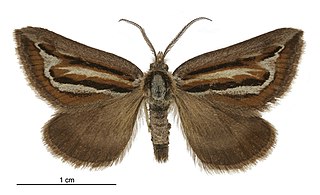
Aponotoreas synclinalis is a moth of the family Geometridae. It is endemic to New Zealand.
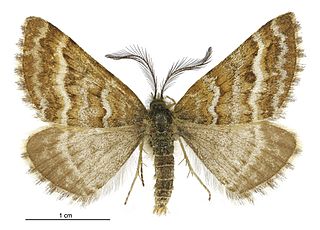
Aponotoreas villosa is a moth of the family Geometridae. It is endemic to New Zealand.

Arctesthes catapyrrha is a moth of the family Geometridae. It is endemic to New Zealand.

Asaphodes adonis is a species of moth in the family Geometridae. It is endemic to the South Island of New Zealand. It is found in native forest at altitudes of between 300 and 1200 metres. Larvae have been reared on species of Ranunculus. Adults are on the wing in January and February.

Asaphodes beata is a species of moth in the family Geometridae. It is endemic to New Zealand and is a relatively common species that can be found throughout the country in native forest or scrub habitat. It can be distinguished from its close relative Asaphodes adonis by the colour of its hind wings. The larvae of this species feeds on watercress but tends to be inactive during the day. If threatened it will mimic a twig dropping to the ground. The adult moths are on the wing from October to March and are said to be attracted to white rātā. The white markings on the forewing of the adults are variable in appearance.

Gingidiobora nebulosa, the gingidium looper moth, is a moth in the family Crambidae. It is endemic to New Zealand. This species has been classified as Nationally Vulnerable by the Department of Conservation.
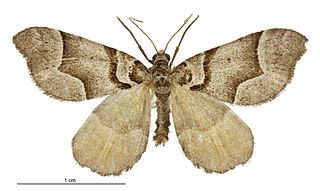
Helastia siris is a moth of the family Geometridae. This species is endemic to New Zealand. It is classified as "At Risk, Relict'" by the Department of Conservation.
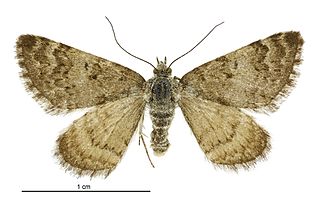
Paranotoreas fulva is a species of moth in the family Geometridae. This species is endemic to New Zealand and is found in the southern half of the South Island. The preferred habitat of this species are the salt pans of Otago, the mountainous grassland areas in South Canterbury and Otago and the glacial outwash terraces south of Tekapo. The larvae feed on Atriplex buchananii and Plantago coronopus. Adults are day flying and have been recorded as being on the wing in March, October and December. P. fulva is classified as "At Risk, Relict" by the Department of Conservation.
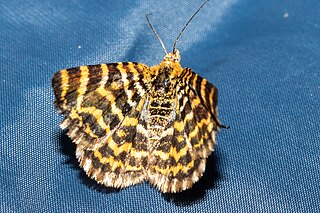
Notoreas galaxias is a species of moth in the family Geometridae. This species is endemic to New Zealand and has been observed in the southern half of the South Island. The species inhabits alpine herbfields and their larvae feed on species in the genera Kelleria and Drapetes. The adults are on the wing February to March.

Helastia corcularia is a moth of the family Geometridae. This species is endemic to New Zealand and is found only in the South Island and the Chatham Islands. It inhabits a wide variety of habitats including native forest and scrubland, gardens, parks, subalpine and coastal areas. Larvae feed on herbs, lichen and moss. The adults of the species are on the wing from September until May and are nocturnal and attracted to light. H. corcularia is considered an orchard and pack house contaminant.

Helastia farinata is a moth of the family Geometridae. It was first described by William Warren in 1896. This species is endemic to New Zealand and is found in the North Island. H. farinata inhabits shady and damp forest ravines.

Helastia semisignata is a moth of the family Geometridae. This species is endemic to New Zealand and is only found in the North Island. The life history of this species is in need of further investigation as sources differ about what plants host the larvae. Adults are on the wing commonly from October until March.

Paranotoreas ferox is a species of moth in the family Geometridae. This species is endemic to New Zealand. This species was first described by Arthur Gardiner Butler in 1877 and named Fidonia ferox. In 1986 Robin C. Craw placed this species within the genus Paranotoreas.

Xanthorhoe orophylloides is a moth of the family Geometridae. It was first described by George Hudson in 1909 and is endemic to New Zealand. This species is found in the subantarctic islands including at the Auckland Islands and at Campbell Island.




















